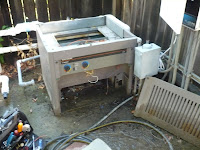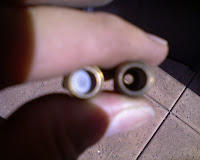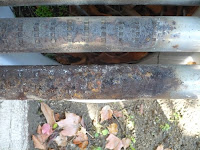 |
| Hayward H-series Heater |
A couple of weeks ago I ran across a Hayward H-series heater (atmospheric, not low NOx) that failed to light. It would go through its start-up sequence: It activated the spark igniter and opened the gas valve and then fail to light. A couple of times it lit with a
boomand then just as quickly the flame went out.
 |
Orifice blocked by spider web next
to open (good) orifice |
Usually this indicates that spiders have built webs that block the tiny orifice that supplies gas to the burners. When the orifice for the burner that is under the igniter is clogged, the heater often fails to light. Occasionally, enough gas from the other burners will build up in a cloud and drift over towards the igniter. In this case, it lights with a boom.
 |
| Burner with openings blocked by rust |
But today, that was not the problem. As the picture shows, rust deposits have built up on the burner and are blocking the openings. The rust was particularly bad on the burner that is under the igniter.
The rust came about because the heater is "condensing." This happens when condensation forms on the heat exchanger (located directly over the burners). The condensation then drips down onto the burners. You can often hear the effects of a condensing heater. It will sound like water being flicked onto a hot skillet.
The way to fix the problem is to replace both bypass valves in the inlet/outlet header. There is one bypass that operates on pressure and one that relates to temperature. Either could cause this problem and since it takes a good deal of labor to get in there, it is better to replace both. Then, after fixing the cause, fix the damage by replacing as many burners as necessary.



Comments
My Husband is the only one that does Heaters and he says the are a pain but simple! I cant understand them LOL :-)
Kevin,
You are quite right about the problems caused by low gas pressure. Check out my most recent blog post that looks deeper into the combustion chemistry related to that problem.
Lester,
I too have seen pieces of the refractory crumble and fall down on the burners. Even a small piece can cause the heater to roll out or "boom" as it lights if it blocks the burners near the igniter. Larger missing pieces can additionally cause hot spots on the outside of the combustion chamber creating a fire hazard or even causing internal heater components to melt.
Thanks guys for your comments!
Clint
Not only will excessive water flow create condesation, but also low gas pressure. That's very important.
Not only will the burners rust, but the cabinet will eventually rot away.
Make sure your gas pipe is sized correctly for the BTU of the heater and the distance from the meter to the heater. Elbows and 45's add additional restrictions and must be counted in the overall run.
Excessive water flow through brass and copper materials in a heater become damaged quickly. Also, acidic water conditions create havoc. And we all know our customer's ALWAYS KEEP THEIR WATER BALANCED
Clint, I can relate to your heater blogs. I had a new heater one time,with a spider web in the pilot orifice.I've also had spider webs in the burner tubes.Also the old refractory that would crumble and fall down on the burners.